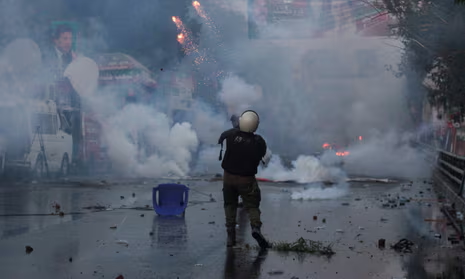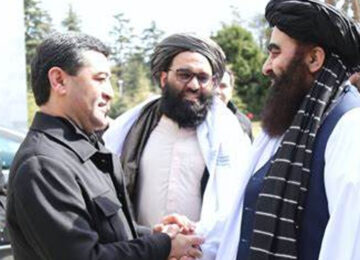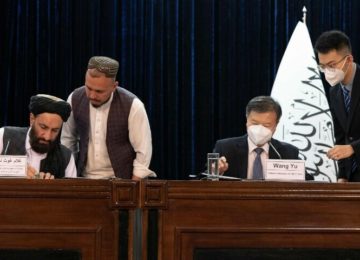They are like the camel’s nose, lifting a corner of the tent. Don’t be fooled, though. It won’t take long until the whole animal is sitting inside, sipping your tea and eating your sweets. In countries around the world — in the Middle East, Asia Minor, Central Asia, Africa, even the Philippines — the appearance of U.S. drones in the sky (and on the ground) is often Washington’s equivalent of the camel’s nose entering a new theater of operations in this country’s forever war against “terror.” Sometimes, however, the drones are more like the camel’s tail, arriving after less visible U.S. military forces have been in an area for a while.
Scrambling for Africa
AFRICOM, the Pentagon’s Africa Command, is building Air Base 201 in Agadez, a town in the nation of Niger. The $110 million installation, which officially opens later this year, will be able to house both C-17 transport planes and MQ-9 Reaper armed drones. It will soon become the new centerpiece in an undeclared U.S. war in West Africa. Even before the base opens, armed U.S. drones are already flying from Niger’s capital, Niamey, having received permission from the Nigerien government to do so last November.
Despite crucial reporting by Nick Turse and others, most people in this country only learned of U.S. military activities in Niger in 2017 (and had no idea that about 800 U.S. military personnel were already stationed in the country) when news broke that four U.S. soldiers had died in an October ambush there. It turns out, however, that they weren’t the only U.S soldiers involved in firefights in Niger. This March, the Pentagon acknowledged that another clash took place last December between Green Berets and a previously unknown group identified as ISIS-West Africa. For those keeping score at home on the ever-expanding enemies list in Washington’s war on terror, this is a different group from the Islamic State in the Greater Sahara (ISGS), responsible for the October ambush. Across Africa, there have been at least eight other incidents, most of them in Somalia.
What are U.S. forces doing in Niger? Ostensibly, they are training Nigerien soldiers to fight the insurgent groups rapidly multiplying in and around their country. Apart from the uranium that accounts for over 70% of Niger’s exports, there’s little of economic interest to the United States there. The real appeal is location, location, location. Landlocked Niger sits in the middle of Africa’s Sahel region, bordered by Mali and Burkina Faso on the west, Chad on the east, Algeria and Libya to the north, and Benin and Nigeria to the south. In other words, Niger has the misfortune to straddle a part of Africa of increasing strategic interest to the United States.
In addition to ISIS-West Africa and ISGS, actual or potential U.S. targets there include Boko Haram (born in Nigeria and now spread to Mali and Chad), ISIS and al-Qaeda in the Lands of the Islamic Maghreb (AQIM) in Libya, and Al Mourabitoun, based primarily in Mali.
At the moment, for instance, U.S. drone strikes on Libya, which have increased under the Trump administration, are generally launched from a base in Sicily. However, drones at the new air base in Agadez will be able to strike targets in all these countries.
Suppose a missile happens to kill some Nigerien civilians by mistake (not exactly uncommon for U.S. drone strikes elsewhere)? Not to worry: AFRICOM is covered. A U.S.-Niger Status of Forces Agreement guarantees that there won’t be any repercussions. In fact, according to the agreement, “The Parties waive any and all claims… against each other for damage to, loss, or destruction of the other’s property or injury or death to personnel of either Party’s armed forces or their civilian personnel.” In other words, the United States will not be held responsible for any “collateral damage” from Niger drone strikes. Another clause in the agreement shields U.S. soldiers and civilian contractors from any charges under Nigerien law.
The introduction of armed drones to target insurgent groups is part of AFRICOM’s expansion of the U.S. footprint on a continent of increasing strategic interest to Washington. In the nineteenth and early twentieth centuries, European nations engaged in the “scramble for Africa,” a period of intense and destructive competition for colonial possessions on the continent. In the post-colonial 1960s and 1970s, the United States and the Soviet Union vied for influence in African countries as diverse as Egypt and what is now the Democratic Republic of the Congo (DRC).
Today, despite AFRICOM’s focus on the war on terror, the real jockeying for influence and power on the continent is undoubtedly between this country and the People’s Republic of China. According to the Council on Foreign Relations, “China surpassed the United States as Africa’s largest trade partner in 2009” and has never looked back. “Beijing has steadily diversified its business interests in Africa,” the Council’s 2017 backgrounder continues, noting that from Angola to Kenya,
“China has participated in energy, mining, and telecommunications industries and financed the construction of roads, railways, ports, airports, hospitals, schools, and stadiums. Investment from a mixture of state and private funds has also set up tobacco, rubber, sugar, and sisal plantations… Chinese investment in Africa also fits into Chinese President Xi Jinping’s development framework, ‘One Belt, One Road.’”
For example, in a bid to corner the DRC’s cobalt and copper reserves (part of an estimated $24 trillion in mineral wealth there), two Chinese companies have formed Sicomines, a partnership with the Congolese government’s national mining company. The Pulitzer Center reports that Sicomines is expected “to extract 6.8 million tons of copper and 427,000 tons of cobalt over the next 25 years.” Cobalt is essential in the manufacture of today’s electronic devices — from cell phones to drones — and more than half of the world’s supply lies underground in the DRC.
Even before breaking ground on Air Base 201 in Niger, the United States already had a major drone base in Africa, in the tiny country of Djibouti in the Horn of Africa, across the Gulf of Aden from Yemen. From there, the Pentagon has been directing strikes against targets in Yemen and Somalia. As AFRICOM commander Gen. Thomas Waldhauser told Congress in March, “Djibouti is a very strategic location for us.” Camp Lemonnier, as the base is known, occupies almost 500 acres near the Djibouti-Ambouli International Airport. U.S. Central Command, Special Operations Command, European Command, and Transportation Command all use the base. At present, however, it appears that U.S. drones stationed in Djibouti and bound for Yemen and Somalia take off from nearby Chabelley Airfield, as Bard College’s Center for the Study of the Drone reports.
To the discomfort of the U.S. military, the Chinese have recently established their first base in Africa, also in Djibouti, quite close to Camp Lemonnier. That country is also horning in on potential U.S. sales of drones to other countries. Indonesia, Saudi Arabia, and the United Arab emirates are among U.S. allies known to have purchased advanced Chinese drones.
The Means Justify the End?
From the beginning, the CIA’s armed drones have been used primarily to kill specific individuals. The Bush administration launched its global drone assassination program in October 2001 in Afghanistan, expanded it in 2002 to Yemen, and later to other countries. Under President Barack Obama, White House oversight of such assassinations only gained momentum (with an official “kill list” and regular “terror Tuesday” meetings to pick targets). The use of drones expanded 10-fold, with growing numbers of attacks in Pakistan, Yemen, Libya, and Somalia, as well as in the Afghan, Iraqi, and Syrian war zones. Early on, targets were generally people identified as al-Qaeda leaders or “lieutenants.” In later years, the kill lists grew to include supposed leaders or members of a variety of other terror organizations, and eventually even unidentified people engaged in activities that were to bear the “signature” of terrorist activity.
But those CIA drones, destructive as they were (leaving civilian dead, including children, in their wake) were just the camel’s nose — a way to smuggle in a major change in U.S. policy. We’ve grown so used to murder by drone in the last 17 years that we’ve lost sight of an important fact: such assassinations represented a fundamental (and unlawful) change in U.S. military strategy. Because unpiloted airplanes eliminate the physical risk to American personnel, the United States has embraced a strategy of global extrajudicial executions: presidential assassinations on foreign soil.
It’s a case of the means justifying the end. The drones work so well at so little cost (to us) that it must be all right to kill people with them.
Successive administrations have implemented this strategic change with little public discussion. Critiques of the drone program tend to focus — not unreasonably — on the many additional people (like family members) who are injured or die along with the intended targets, and on civilians who should never have been targets in the first place. But few critics point out that executing foreign nationals without trial in other countries is itself wrong and illegal under U.S. law, as well as that of other countries where some of the attacks have taken place, and of course, international law.
How have the Bush, Obama, and now Trump administrations justified such killings? The same way they justified the expansion of the war on terror itself to new battle zones around the world — through Congress’s September 2001 Authorization for the Use of Military Force (AUMF). That law permitted the president
“to use all necessary and appropriate force against those nations, organizations, or persons he determines planned, authorized, committed, or aided the terrorist attacks that occurred on September 11, 2001, or harbored such organizations or persons, in order to prevent any future acts of international terrorism against the United States by such nations, organizations or persons.”
Given that many of the organizations the United States is targeting with drones today didn’t even exist when that AUMF was enacted and so could hardly have “authorized” or “aided” in the 9/11 attacks, it offers, at best, the thinnest of coverage indeed for such a worldwide program.
Droning On and On
George W. Bush launched the CIA’s drone assassination program and that was just the beginning. Even as Barack Obama attempted to reduce the number of U.S. ground troops in Iraq and Afghanistan, he ramped up the use of drones, famously taking personal responsibility for targeting decisions. By some estimates, he approved 10 times as many drone attacks as Bush.
In 2013, the Obama administration introduced new guidelines for drone strikes, supposedly designed to guarantee with “near certainty” the safety of civilians. Administration officials also attempted to transfer most of the operational responsibility for drone attacks from the CIA to the military’s only-slightly-less-secretive Joint Special Operations Command (JSOC). Although the number of CIA strikes did drop, the Agency remained in a position to rev up its program at any time, as the Washington Post reported in 2016:
“U.S. officials emphasized that the CIA has not been ordered to disarm its fleet of drones, and that its aircraft remain deeply involved in counterterrorism surveillance missions in Yemen and Syria even when they are not unleashing munitions.”
It’s indicative of how easily drone killings have become standard operating procedure that, in all the coverage of the confirmation hearings for the CIA’s new director, Gina Haspel, there was copious discussion of the Agency’s torture program, but not a public mention of, let alone a serious question about, its drone assassination campaign. It’s possible the Senate Intelligence Committee discussed it in their classified hearing, but the general public has no way of knowing Haspel’s views on the subject.
However, it shouldn’t be too hard to guess. It’s clear, for instance, that President Trump has no qualms about the CIA’s involvement in drone killings. When he visited the Agency’s headquarters in Langley, Virginia, the day after his inauguration, says the Post, “Trump urged the CIA to start arming its drones in Syria. ‘If you can do it in 10 days, get it done,’ he said.” At that same meeting, CIA officials played a tape of a drone strike for him, showing how they’d held off until the target had stepped far enough away from the house that the missile would miss it (and so its occupants). His only question: “Why did you wait?”
You may recall that, while campaigning, the president told Fox News that the U.S. should actually be targeting certain civilians. “The other thing with the terrorists,” he said, “is you have to take out their families, when you get these terrorists, you have to take out their families. They care about their lives, don’t kid yourself. When they say they don’t care about their lives, you have to take out their families.” In other words, he seemed eager to make himself a future murderer-in-chief.
How, then, has U.S. drone policy fared under Trump? The New York Times has reported major changes to Obama-era policies. Both the CIA’s and the military’s “kill lists” will no longer be limited to key insurgent leaders, but expanded to include “foot-soldier jihadists with no special skills or leadership roles.” The Times points out that this “new approach would appear to remove some obstacles for possible strikes in countries where Qaeda- or Islamic State-linked militants are operating, from Nigeria to the Philippines.” And no longer will attack decisions only be made at the highest levels of government. The requirement for having a “near certainty” of avoiding civilian casualties — always something of a fiction — officially remains in place for now, but we know how seriously Trump takes such constraints.
He’s already overseen the expansion of the drone wars in other ways. In general, that “near certainty” constraint doesn’t apply to officially designated war zones (“areas of active hostility”), where the lower standard of merely avoiding unnecessary civilian casualties prevails. In March 2017, Trump approved a Pentagon request to identify large parts of Yemen and Somalia as areas of “active hostility,” allowing leeway for far less carefully targeted strikes in both places. At the time, however, AFRICOM head General Thomas D. Waldhauser said he would maintain the “near certainty” standard in Somalia for now (which, as it happens, hasn’t stopped Somali civilians from dying by drone strike).
Another change affects the use of drones in Pakistan and potentially elsewhere. Past drone strikes in Pakistan officially targeted people believed to be “high value” al-Qaeda figures, on the grounds that they (like all al-Qaeda leaders) represented an “imminent threat” to the United States. However, as a 2011 Justice Department paper explained, imminence is in the eye of the beholder: “With respect to al-Qaeda leaders who are continually planning attacks, the United States is likely to have only a limited window of opportunity within which to defend Americans.” In other words, once identified as an al-Qaeda leader or the leader of an allied group, you are by definition “continually planning attacks” and always represent an imminent danger, making you a permanent legitimate target.
Under Trump, however, U.S. drones are not only going after those al-Qaeda targets permitted under the 2001 AUMF, but also targeting Afghan Taliban across the border in Pakistan. In other words, these drone strikes are not a continuation of counterterrorism as envisioned under the AUMF, but rather an extension of a revitalized U.S. war in Afghanistan. In general, the law of war allows attacks on a neutral country’s territory only if soldiers chase an enemy across the border in “hot pursuit.” So the use of drones to attack insurgent groups inside Pakistan represents an unacknowledged escalation of the U.S. Afghan War. Another corner of the tent lifted by the camel’s nose?
Transparency about U.S. wars in general, and airstrikes in particular, has also suffered under Trump. The administration, for instance, announced in March that it had used a drone to kill “Musa Abu Dawud, a high-ranking official in al-Qaeda in the Islamic Maghreb,” as the New York Times reported. However, the Times continued, “questions about whether the American military, under the Trump administration, is blurring the scope of operations in Africa were raised… when it was revealed that the U.S. had carried out four airstrikes in Libya from September to January that the Africa Command did not disclose at the time.”
Similarly, the administration has been less than forthcoming about its activities in Yemen. As the Business Insiderreports (in a story updated from the Long War Journal), the U.S. has attacked al-Qaeda in the Arabian Peninsula (AQAP) there repeatedly, but “of the more than 114 strikes against AQAP in Yemen, CENTCOM has only provided details on four, all of which involved high value targets.” Because Trump has loosened the targeting restrictions for Yemen, it’s likely that the other strikes involved low-level targets, whose identity we won’t know.
Just Security, an online roundtable based at New York University, reports the total number of airstrikes there in 2017 as 120. They investigated eight of these and “found that U.S. operations were responsible for the deaths of at least 32 civilians — including 16 children and six women — and injured 10 others, including five children.” Yemeni civilians had a suggestion for how the United States could help them avoid becoming collateral damage: give them “a list of wanted individuals. A list that is clear and available to the public so that they can avoid targeted individuals, protect their children, and not allow U.S. targets to have a presence in their areas.”
A 2016 executive order requires that the federal director of national intelligence issue an annual report by May 1st on the previous year’s civilian deaths caused by U.S. airstrikes outside designated “active hostility” zones. As yet, the Trump administration has not filed the 2017 report.
Bigger and Better Camels Coming Soon to a Tent Near You
This March, a jubilant Fox News reported that the Marine Corps is planning to build a fancy new drone, called the MUX, for Marine Air Ground Task Force Unmanned Aircraft System-Expeditionary. This baby will sport quite a set of bells and whistles, as Fox marveled:
“The MUX will terrify enemies of the United States, and with good reason. The aircraft won’t be just big and powerful: it will also be ultra-smart. This could be a heavily armed drone that takes off, flies, avoids obstacles, adapts and lands by itself — all without a human piloting it.”
In other words, “the MUX will be a drone that can truly run vital missions all by itself.”
Between pulling out of the Iran agreement and moving the U.S. embassy in Israel to Jerusalem, Trump has made it clear that — despite his base’s chants of “Nobel! Nobel!” — he has no interest whatsoever in peace. It looks like the future of the still spreading war on terror under Trump is as clear as MUX.
This article originally appeared on TomDispatch.com on May 25, 2018. Original link.
Disclaimer: Views expressed on this blog are not necessarily endorsed or supported by the Center for Research and Security Studies, Islamabad.








